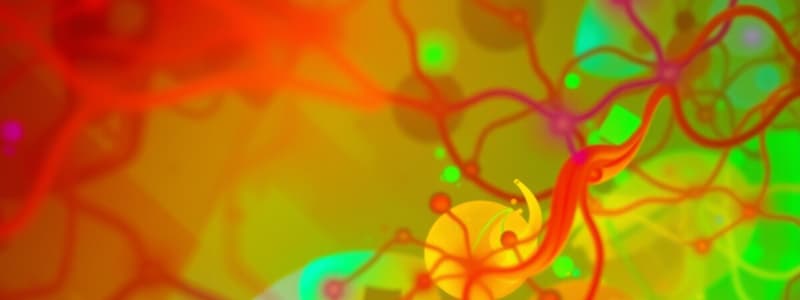Podcast
Questions and Answers
For a given substance, the amount of light absorbed depends upon what four factors? (Select all that apply)
For a given substance, the amount of light absorbed depends upon what four factors? (Select all that apply)
- Solvent (correct)
- Wavelength of light (correct)
- Cell or path length (correct)
- Temperature
- Concentration (correct)
How are percent transmittance and absorbance related algebraically?
How are percent transmittance and absorbance related algebraically?
If all the light passes through a solution without any absorption, then absorbance is zero, and the percent transmittance is 100%. If all the light is absorbed, then percent transmittance is zero, and absorbance is infinite.
What are the five fundamental components of a spectrophotometer? (Select all that apply)
What are the five fundamental components of a spectrophotometer? (Select all that apply)
- Light source (correct)
- Sample cell (correct)
- Refrigerator
- Detector (correct)
- Monochromator (correct)
State the Beer-Lambert law and define all terms in it.
State the Beer-Lambert law and define all terms in it.
What is the purpose of preparing a calibration curve?
What is the purpose of preparing a calibration curve?
Why is hydroxylamine used in this experiment?
Why is hydroxylamine used in this experiment?
If the percent transmittance for a sample is 0 at 350 nm, what is the value of A?
If the percent transmittance for a sample is 0 at 350 nm, what is the value of A?
If your experimental absorbance is greater than 1, how would you modify your procedure?
If your experimental absorbance is greater than 1, how would you modify your procedure?
If 3.0 mL of a standard iron solution (1 mL = 0.050 mg Fe) is diluted to 70 mL, what is the final iron concentration in mg Fe/mL?
If 3.0 mL of a standard iron solution (1 mL = 0.050 mg Fe) is diluted to 70 mL, what is the final iron concentration in mg Fe/mL?
If aqueous Co(NO3)2 has an extinction coefficient of 5.1 L/mol-cm at 505 nm, show that a 0.0600 M Co(NO3)2 solution will give an absorbance of 0.30.
If aqueous Co(NO3)2 has an extinction coefficient of 5.1 L/mol-cm at 505 nm, show that a 0.0600 M Co(NO3)2 solution will give an absorbance of 0.30.
Flashcards
Factors affecting light absorption
Factors affecting light absorption
The amount of light absorbed by a substance depends on solvent, concentration, path length, and molar absorptivity.
Percent transmittance vs absorbance
Percent transmittance vs absorbance
Percent transmittance and absorbance are inversely related; 100% transmittance means absorbance is 0 and vice versa.
Components of a spectrophotometer
Components of a spectrophotometer
A spectrophotometer typically includes a light source, sample holder, detector, monochromator, and readout device.
Beer-Lambert law
Beer-Lambert law
Signup and view all the flashcards
Purpose of a calibration curve
Purpose of a calibration curve
Signup and view all the flashcards
Role of hydroxylamine
Role of hydroxylamine
Signup and view all the flashcards
Absorbance when %T is 0
Absorbance when %T is 0
Signup and view all the flashcards
Diluting high absorbance
Diluting high absorbance
Signup and view all the flashcards
Final concentration calculation
Final concentration calculation
Signup and view all the flashcards
Calculating absorbance with extinction coefficient
Calculating absorbance with extinction coefficient
Signup and view all the flashcards
Study Notes
Light Absorption Factors
- Light absorption in a substance depends on concentration, cell path length, wavelength of light, and the solvent used.
Absorbance and Percent Transmittance Relationship
- Absorbance (A) is zero when percent transmittance is 100%, and vice versa; full absorption leads to zero transmittance and infinite absorbance.
Components of a Spectrophotometer
- The spectrophotometer includes five fundamental components: light source, monochromator, sample cell, detector, and meter.
Beer-Lambert Law
- Beer-Lambert Law is represented as A = abc, where:
- A = absorbance
- a = molar absorptivity (or molar extinction coefficient)
- b = path length of the solution
- c = concentration (in moles per liter)
Calibration Curve Purpose
- A calibration curve helps determine the concentration of an unknown substance by comparing it with standard samples of known concentrations.
Role of Hydroxylamine in Experiment
- Hydroxylamine reduces Fe3+ ions to Fe2+ ions during the experiment.
Calculation of Absorbance from Percent Transmittance
- If percent transmittance is 0 at 350 nm, the absorbance (A) is infinite.
Modifying Procedure for High Absorbance
- If experimental absorbance exceeds 1, solutions should be diluted to achieve accurate measurements.
Iron Concentration Calculation
- Diluting 3.0 mL of standard iron solution (0.050 mg Fe/mL) to 70 mL results in a final concentration of 0.002 mg Fe/mL.
Example Calculation of Absorbance for Co(NO3)2
- For 0.0600 M Co(NO3)2 with an extinction coefficient of 5.1 L/mol-cm at 505 nm, the absorbance (A) calculates to 0.30 using the Beer-Lambert Law: A = (5.1)(1)(0.0600) = 0.30.
Studying That Suits You
Use AI to generate personalized quizzes and flashcards to suit your learning preferences.




